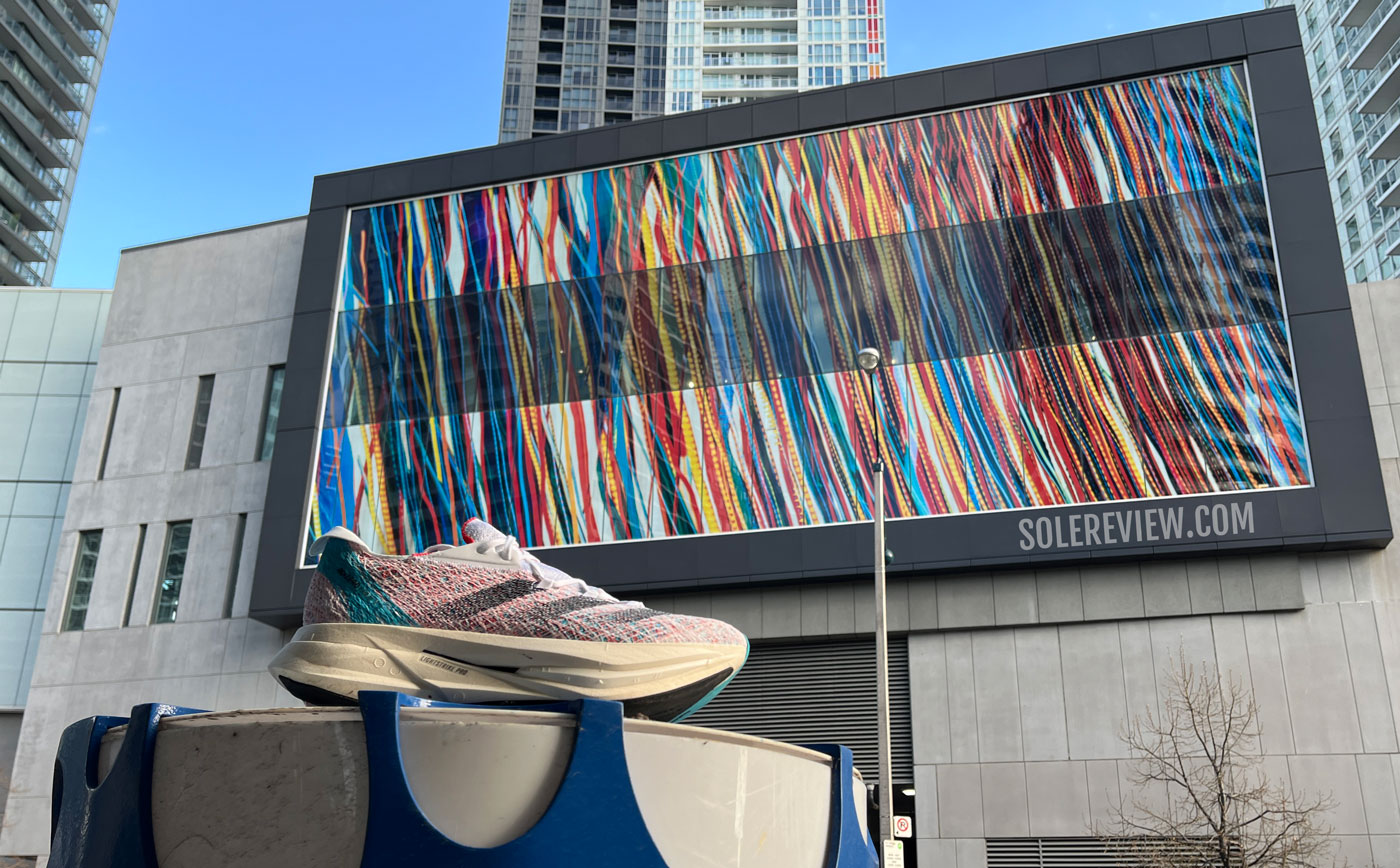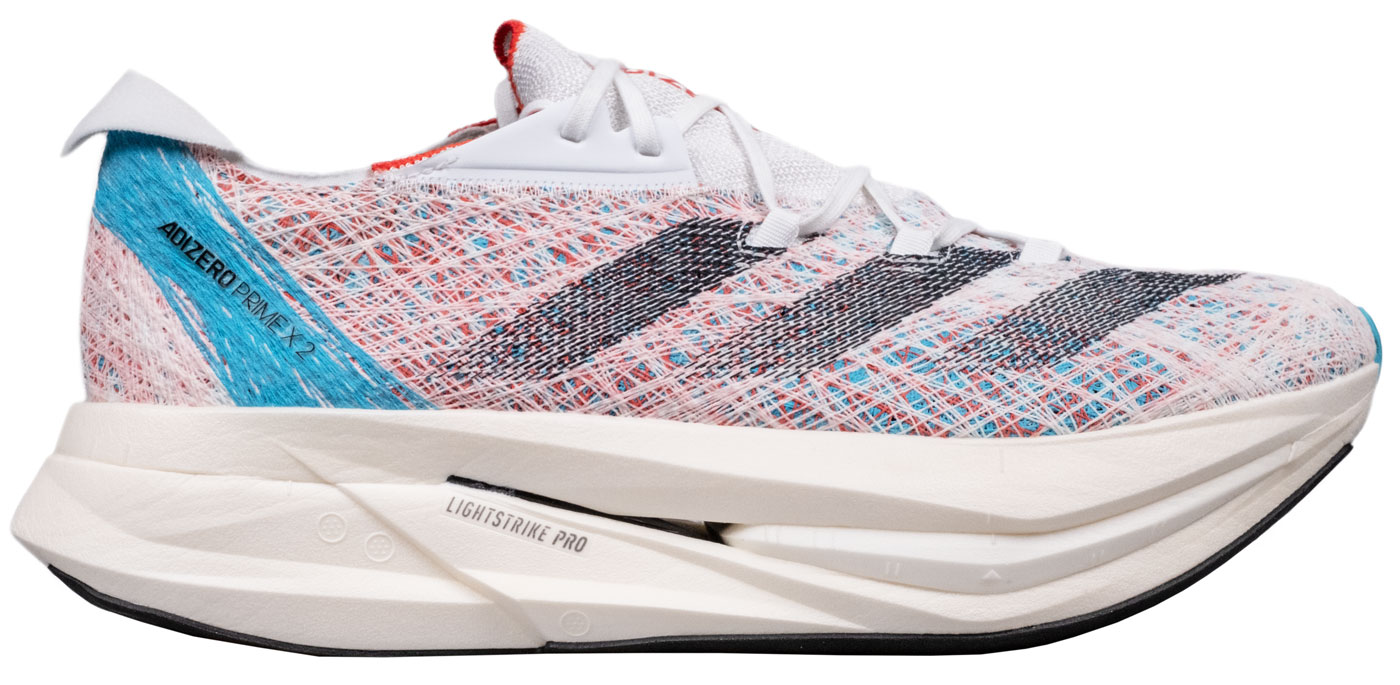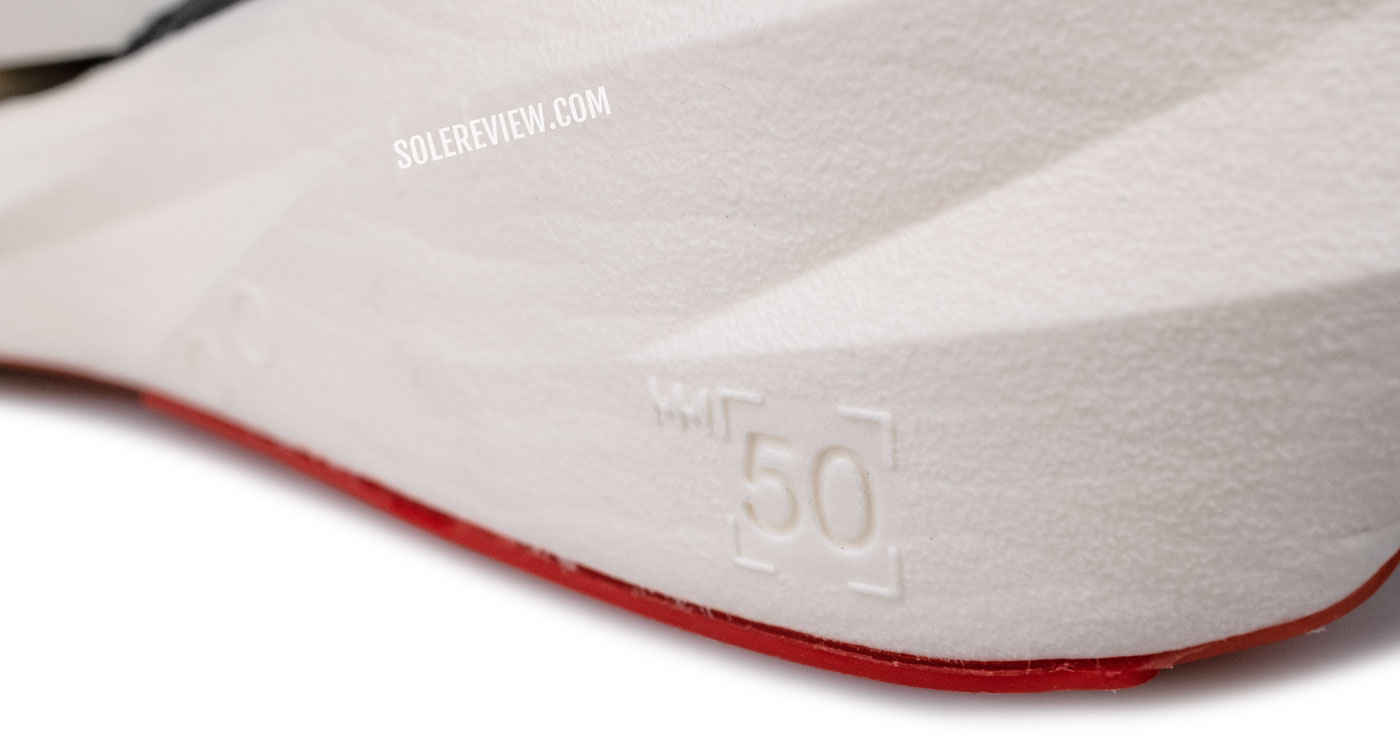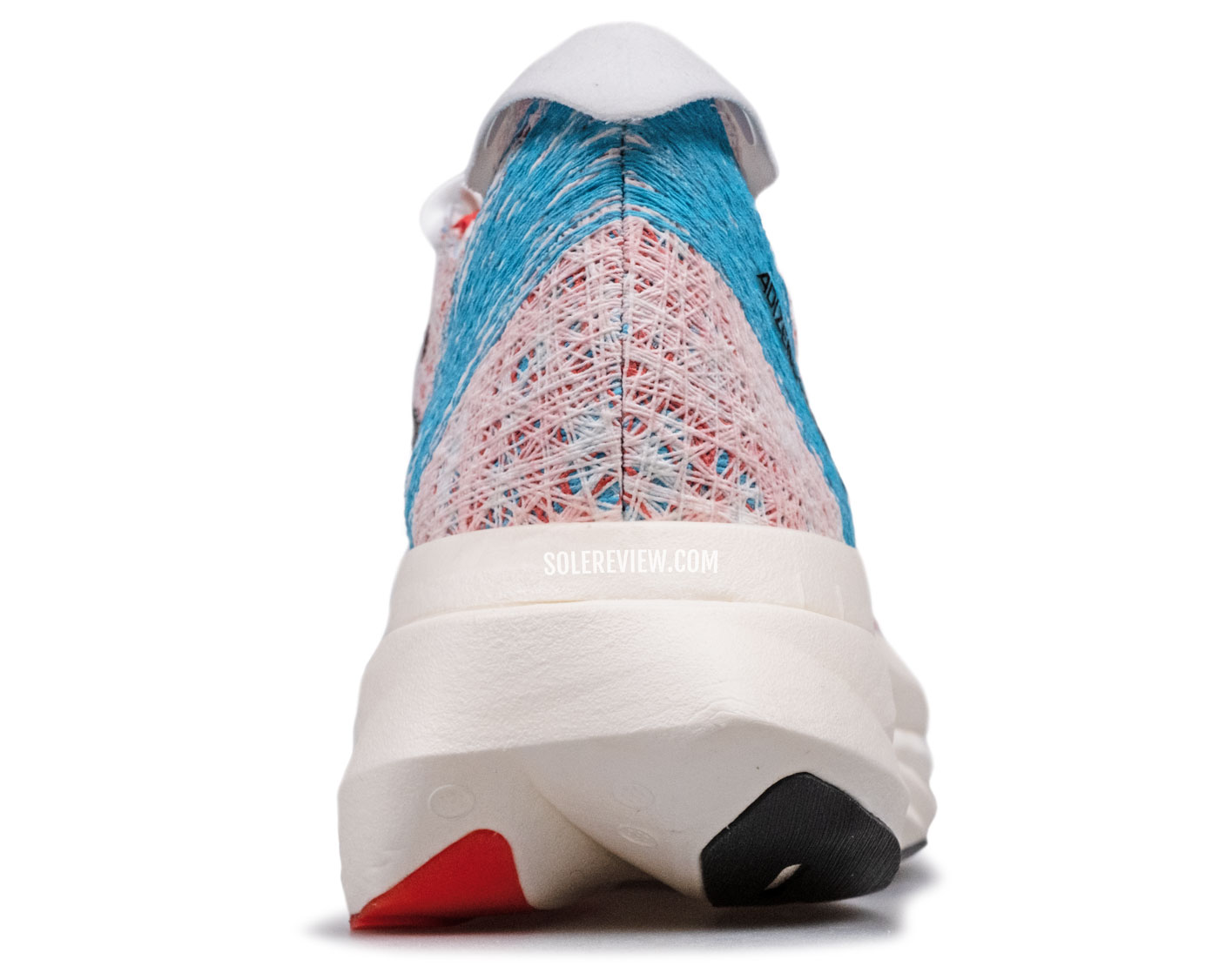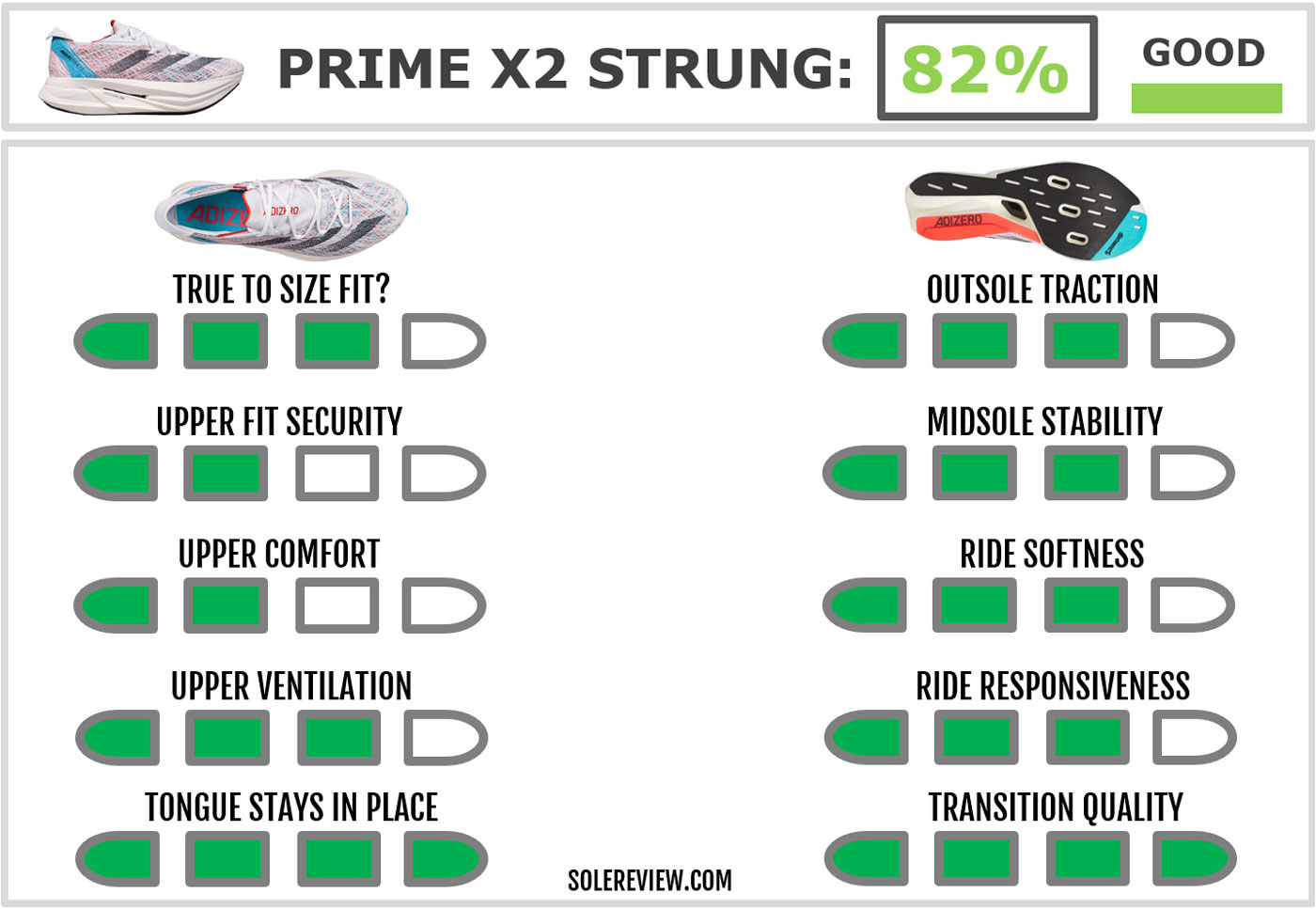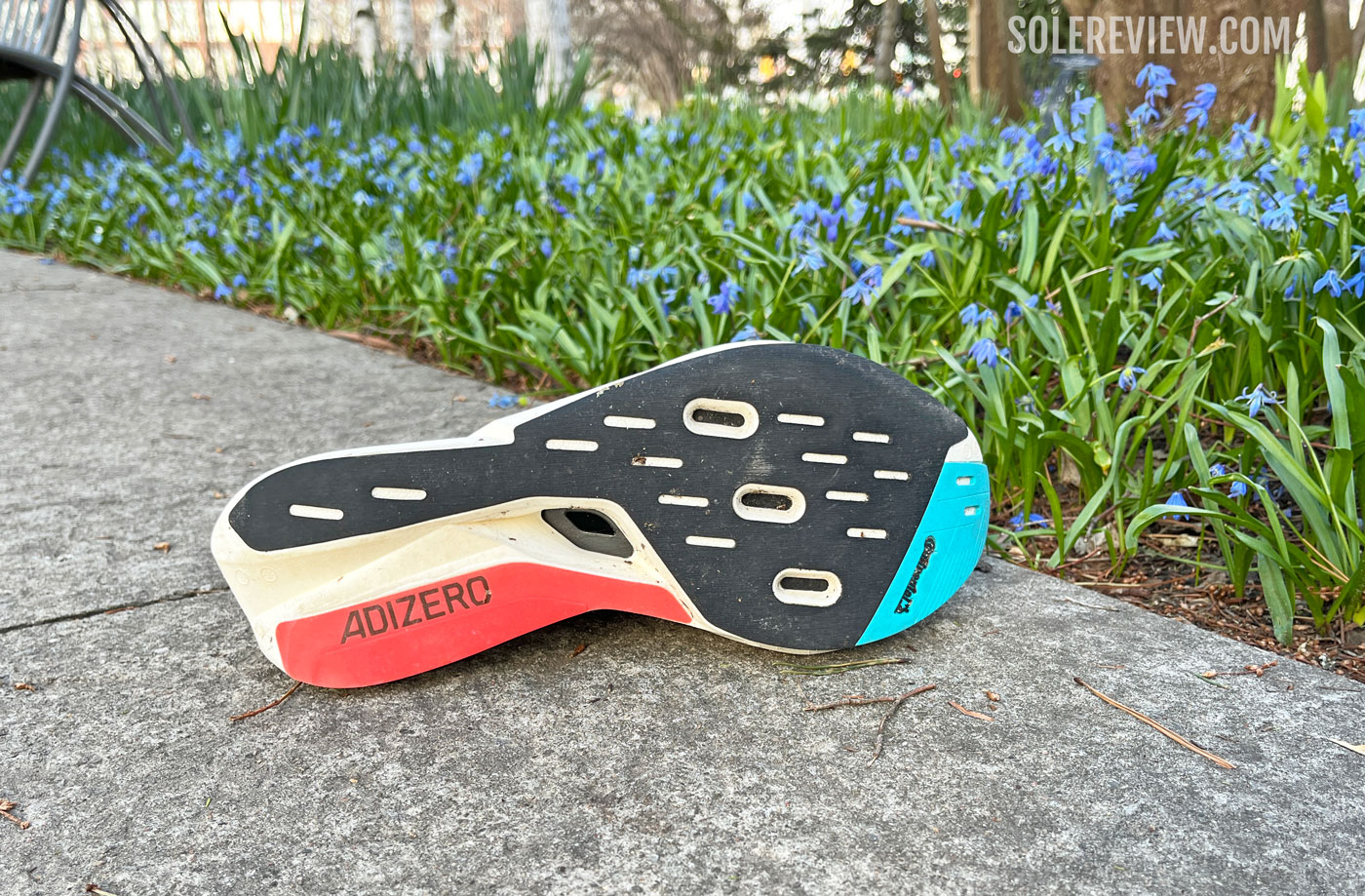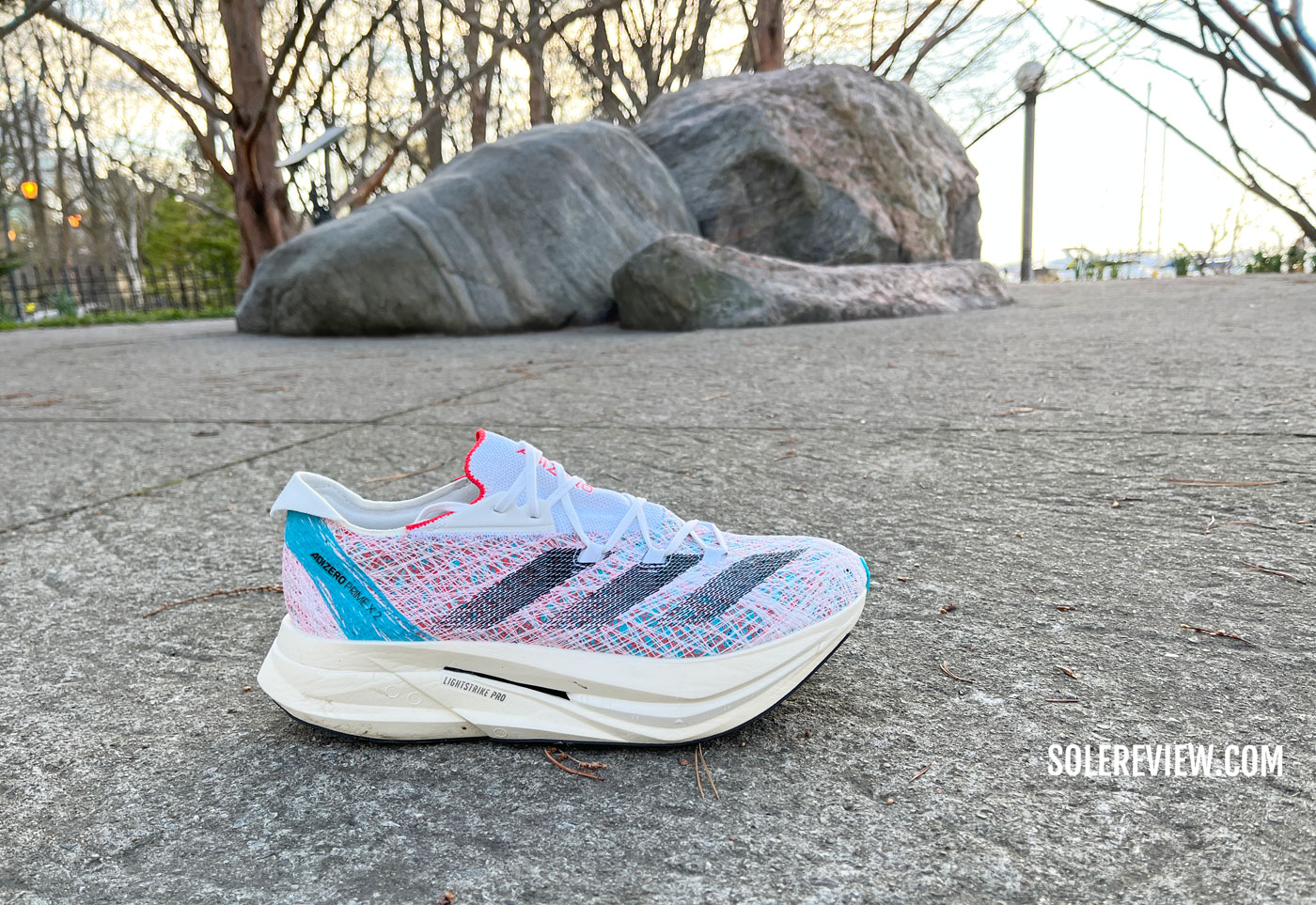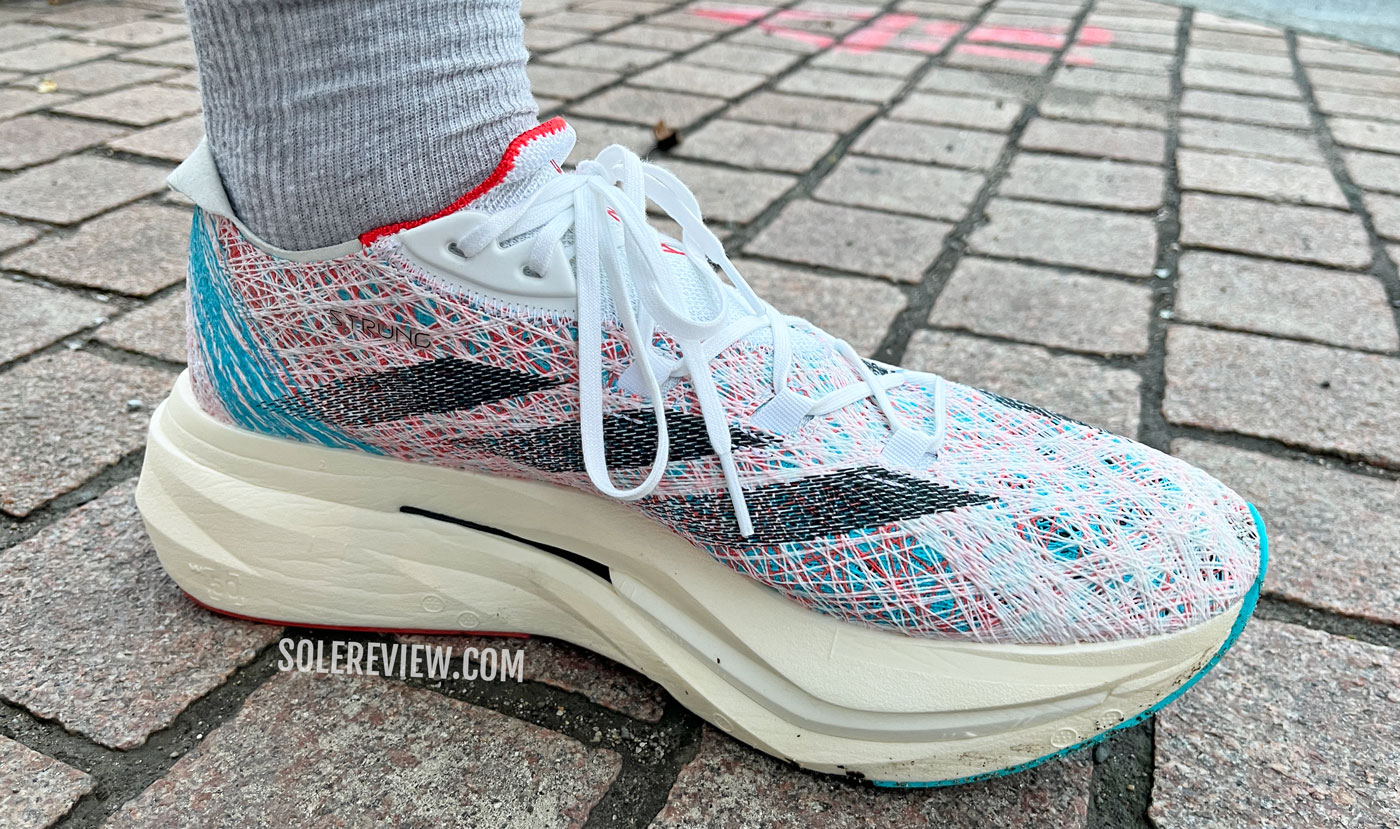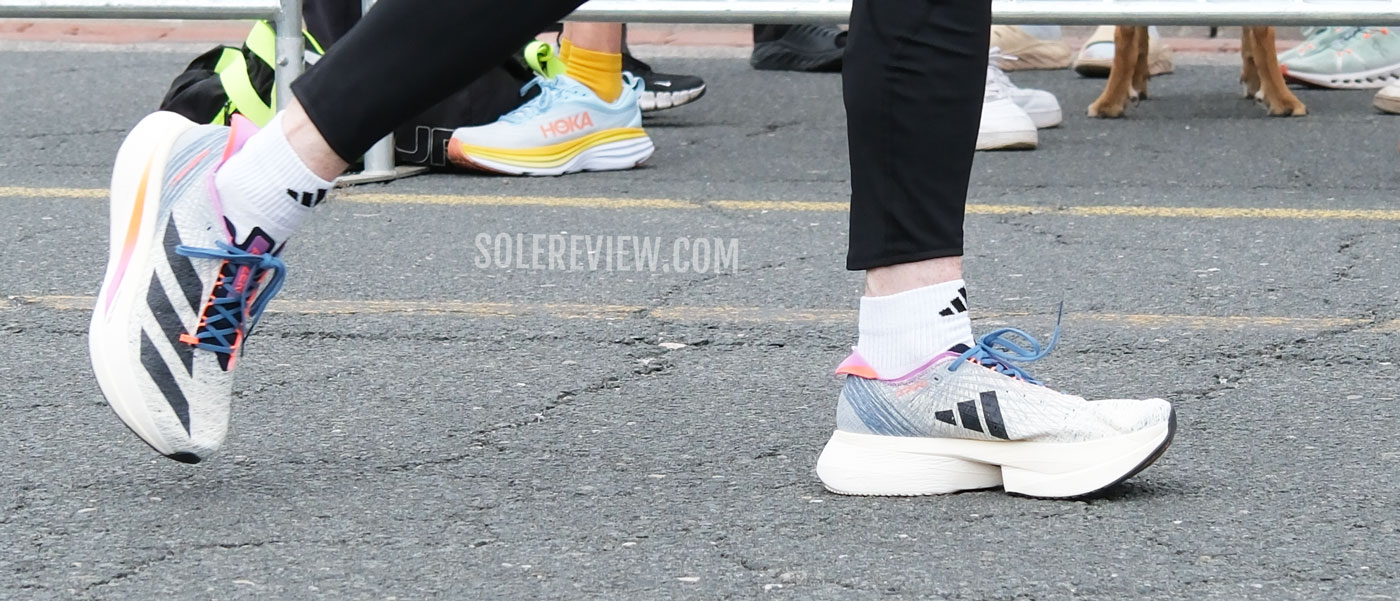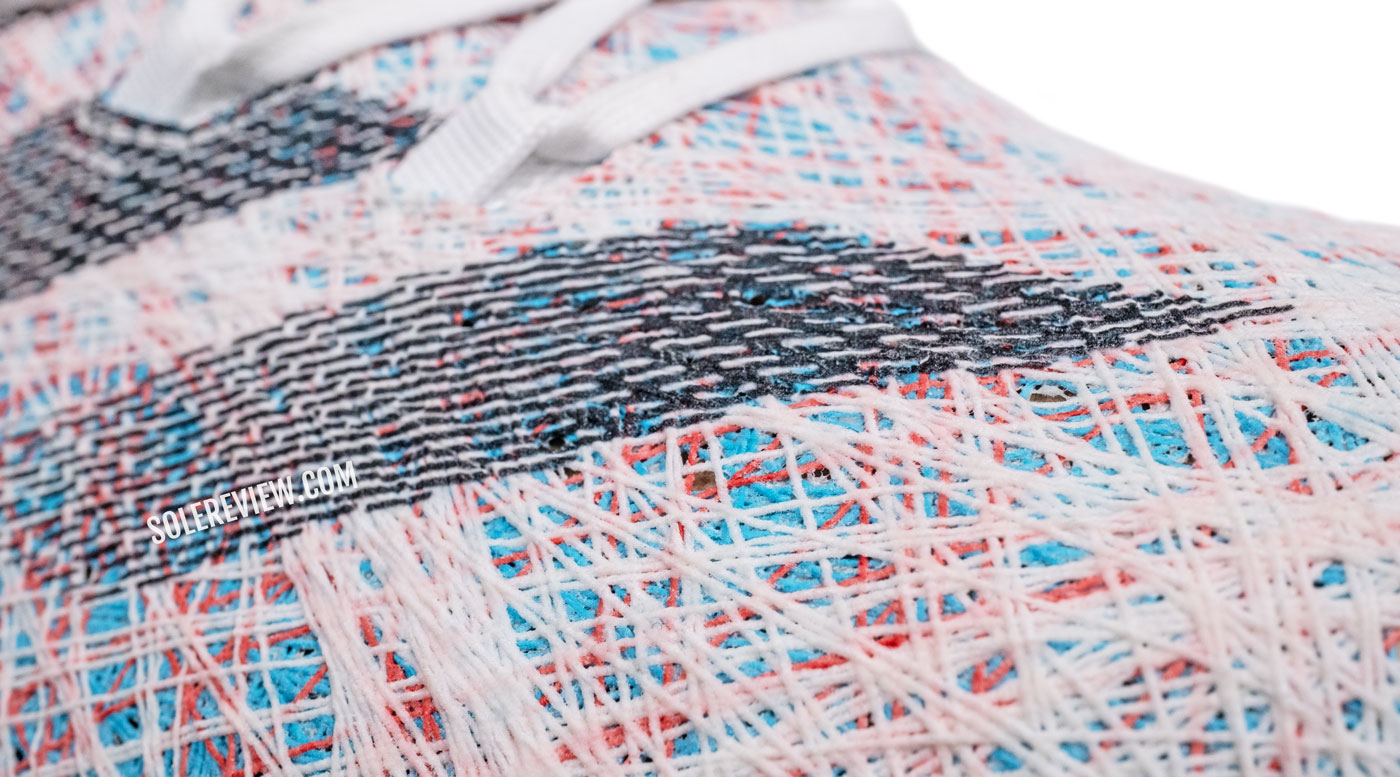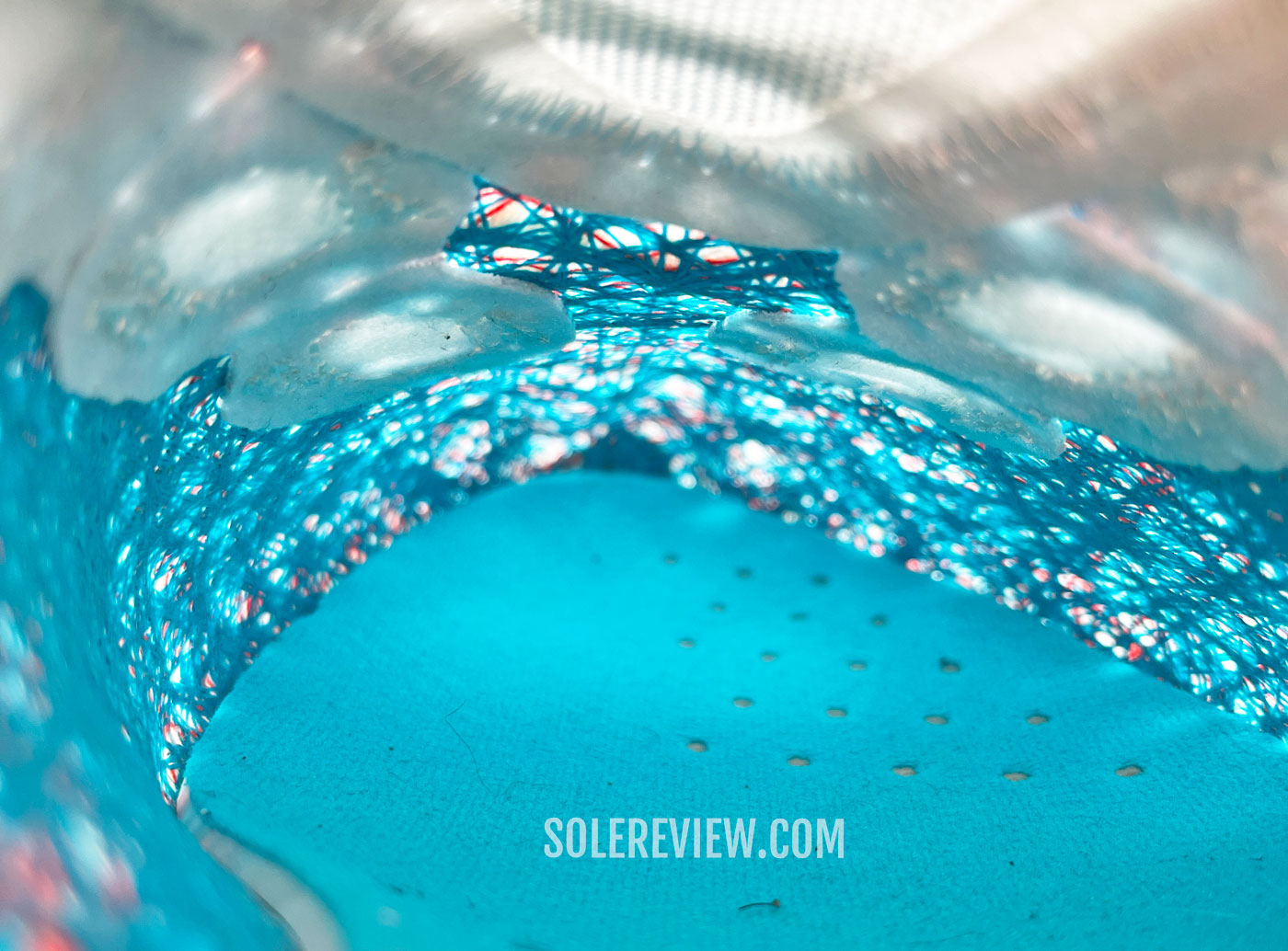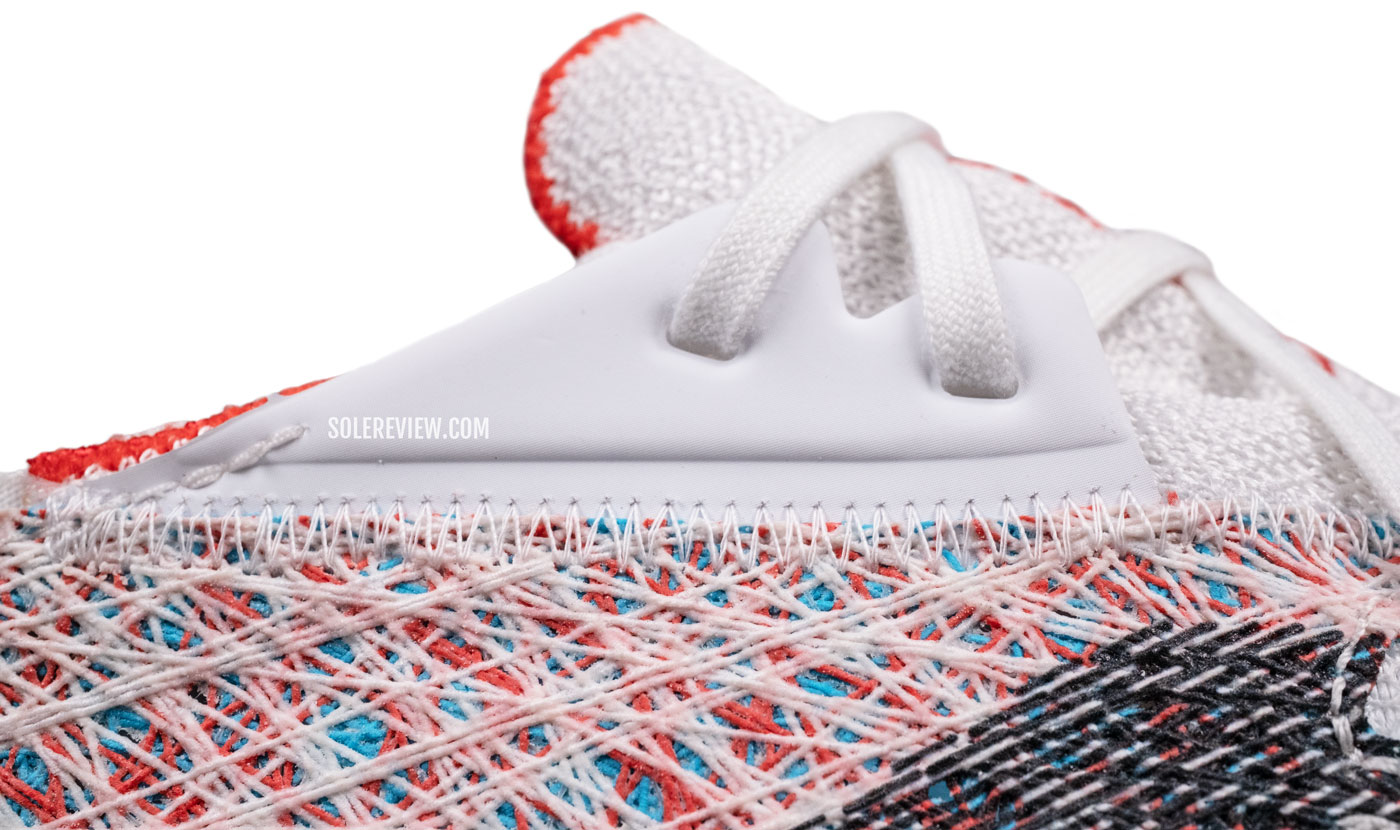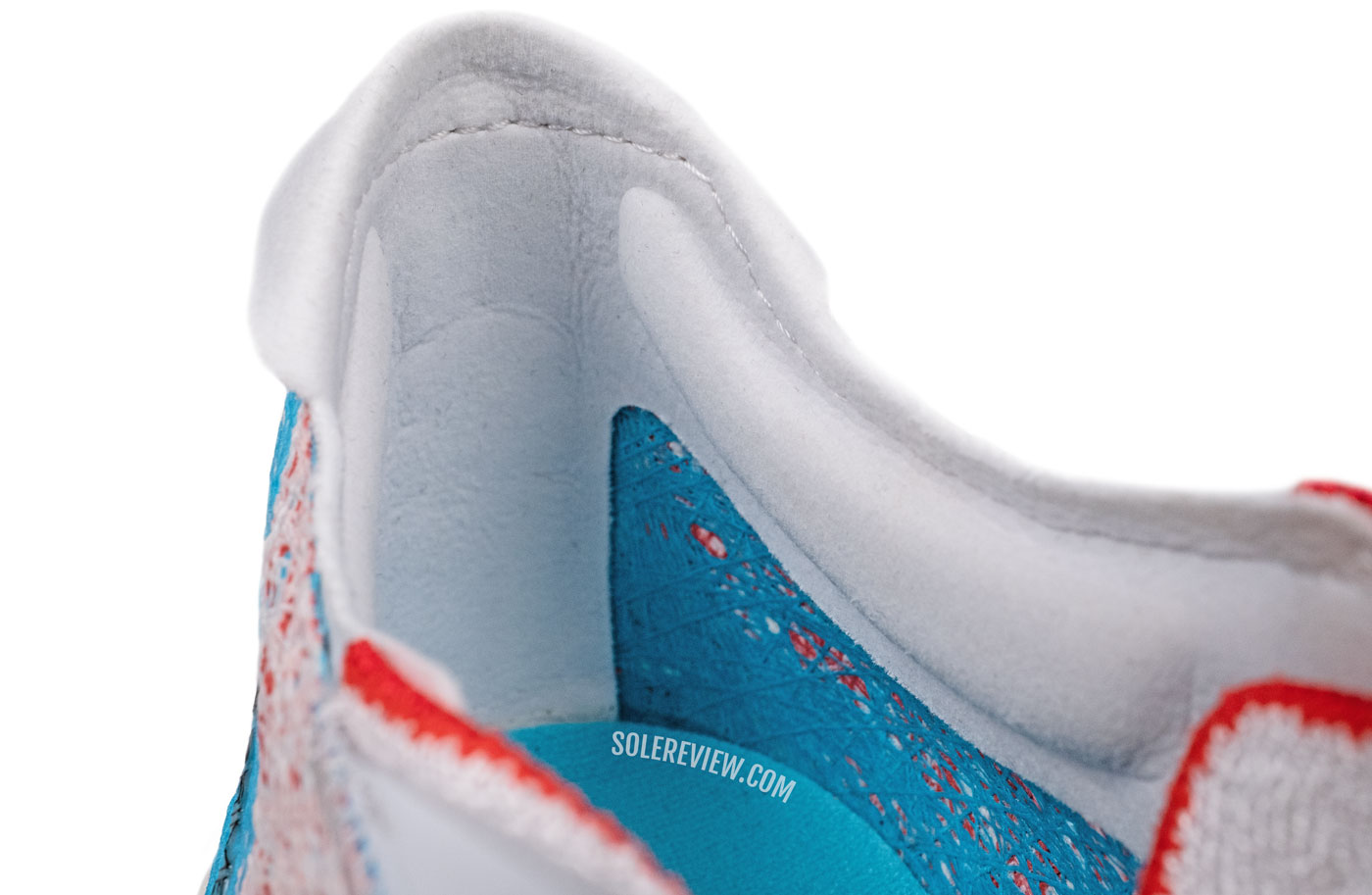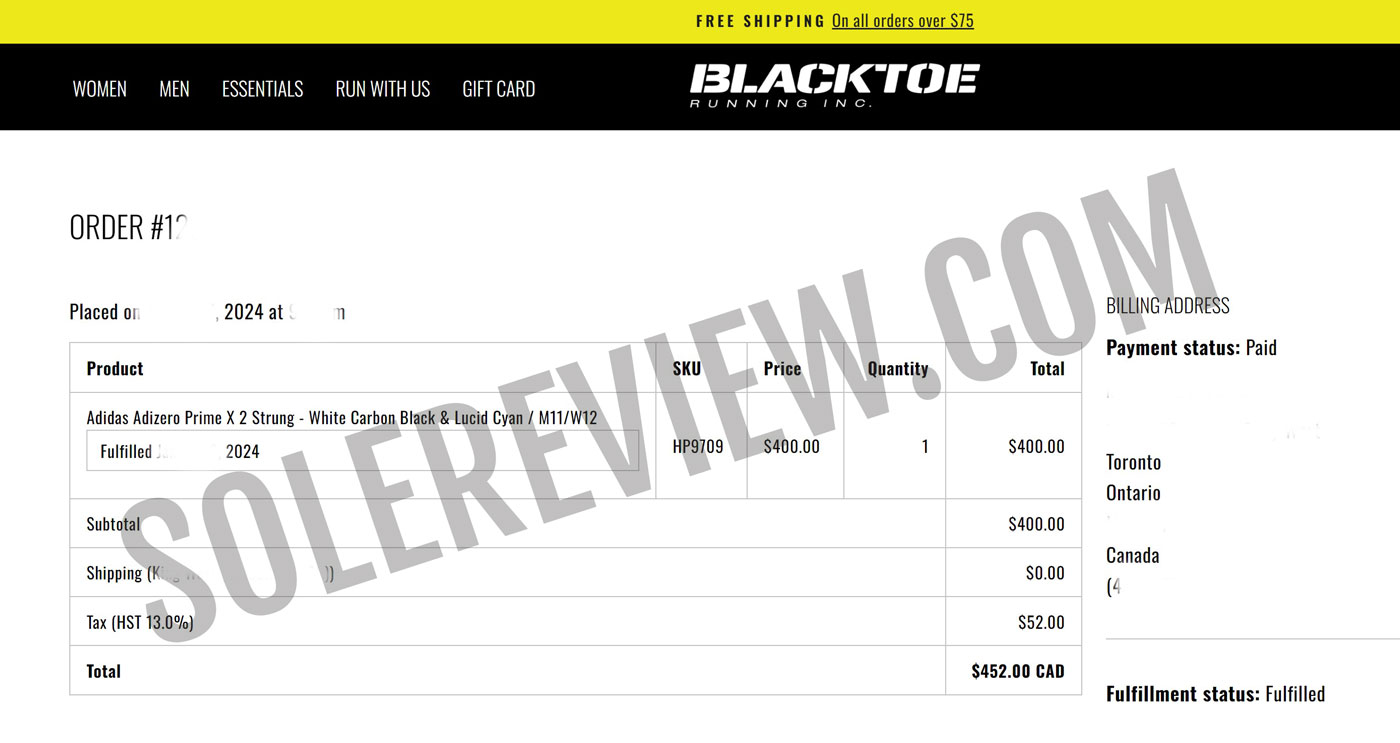
For this review, Solereview paid the full retail price for the Adidas Prime X2 Strung. The amount is in Canadian Dollars.
10 years ago, if someone told us that we would, one day, review a running shoe with two Carbon plates inside a 50 mm tall midsole, we would have laughed at the sheer absurdity of the notion.
But here we are. The three foam layers of the Prime X2’s midsole house not one, but two Carbon-infused plates inside a ridiculously thick stack. At its highest point, the Prime X2 Strung is 50 mm tall – 10 mm over the regulated 40 mm height set by the World Athletics Organization.
Also, World Athletics bans running shoes with more than a single plate. As the Prime X2 breaks both regulations, you won’t see them on the feet of pro athletes.
That’s the headline for this shoe, and adidas isn’t shy about it – ‘illegally fast’ and all that jazz. But just how useful is the Prime X2 Strung?
There’s only one good reason why anyone should buy the $300 Prime X2 Strung, and that would be its combination of deep cushioning and a very propulsive rocker. However, that comes with several caveats; not everyone can tap into the shoe’s full potential. The Prime X2’s suite of tricks is very speed-dependent.
With stack heights of 50 mm (rear) and 43 mm (front), the Prime X2’s cushioning depth has no precedent; it’s even 2 mm taller than PX1’s forefoot. Heavier runners and Clydesdales will not need to worry about ‘bottoming’ the cushioning, as they would with lighter shoes like the Nike Vaporfly 3.
The resilient and relative firmness of the Lightstrike Pro midsole produces satisfactory levels of support. The rearfoot stability could have been better with an internal heel counter on the upper, though. We’ll come back to that later in the review.
On the other hand, if you’re a lightweight runner, the Prime X2 excels at keeping the feet fresh during a long run, as well as propelling the wearer forward with its ultra-effective rocker.
There’s this reservoir of ride comfort that never runs dry. You never get this sense that you wish you had more cushioning during a run. On a hypothetical cushioning scale of 0-10, the Prime X2 Strung will likely land on the yet-to-be-established 12 marker. The Lightstrike Pro midsole is a very effective barrier against ride harshness. Just to be clear, we refer to the cushioning and not softness – while they are often conflated, they mean two different things. The Prime X2 is very cushioned, but not the softest.
When compared to PEBAX-based super foams, the Lightstrike Pro is on the firmer side with better resistance to creasing. Over time, adizero shoes look less beat up than Nike ZoomX and Saucony Pwrrun PB-based midsoles.
While other performance advantages like the outsole grip, rocker shape, and durability aren’t unique to the Prime X, they complement the latter’s generously cushioned character.
Okay, how about the two-plate setup? Isn’t that unique to the Prime X2 Strung? While the mere idea is certainly a novelty in a sea of me-too products, what’s of greater importance is how the dual-plate design interacts with the shoe and the foot.
During a run, it’s exceedingly difficult to tell if there are two plates under the foot, or just one. If you think you can tell the difference, it’s probably because you are already aware of the plate’s existence.
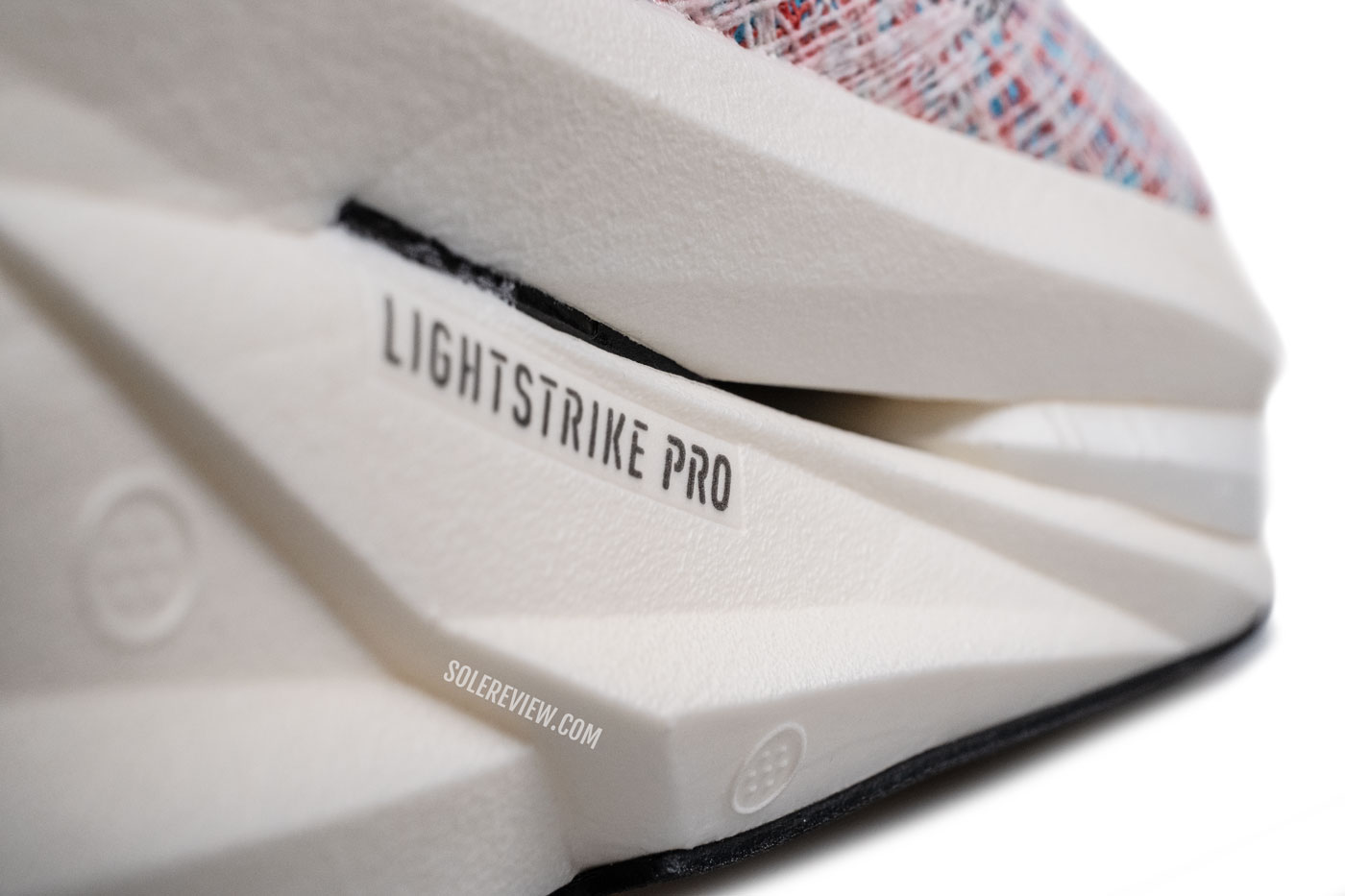
The two plates are laid on top of each other, but are separated by a Lightstrike Pro foam dampener. There are three layers of foam under the forefoot and the heel.
It’s important to remember that there’s no empty space between the plates; there’s a dampening foam plug between the two. Rather, the two-plate construction does two things to the Prime X2 Strung’s ride character.
For one, they make the rocker effect very pronounced. With this shoe, the gait cycle culminates with roll-offs rather than toe-offs; there’s a considerable amount of transition assist available through the rocker.
The Prime X2 achieves this by making the lower plate more curved than the top plate. The sharper curvature of the lower plate gives a rigid structure to the rocker, whereas the top plate creates a transition path while behaving like a Cantilever beam under the heel.
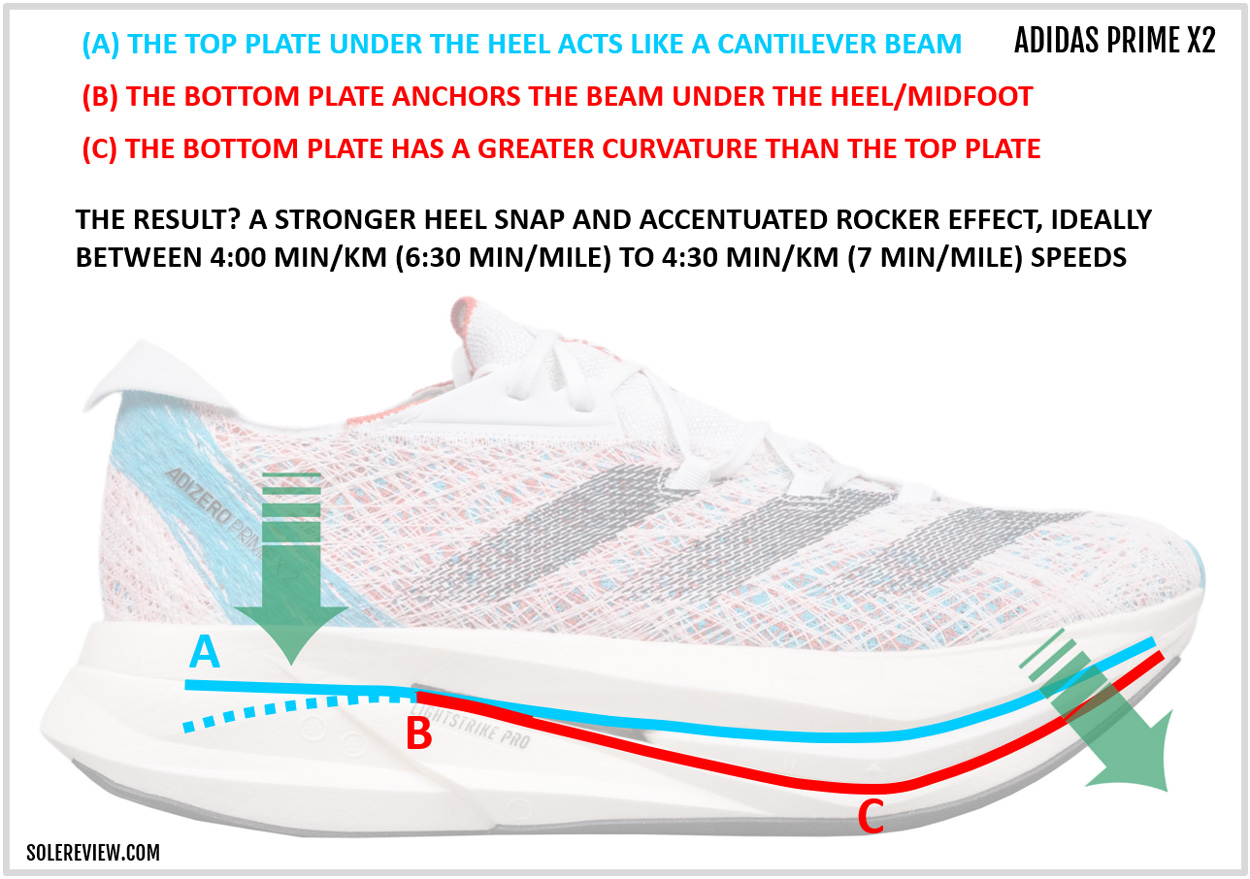
Note: The lower plate (in red) will also deflect/flex when the heel is loaded, but we’ve kept the graphic simple for brevity.
And this is where runners who were just getting used to the PX1 will say: ‘Huh? What happened to the PX1’s ride? The PX2 is a completely different shoe.’
The Energy Rods on the PX1 were easier to work through, so there was this sense of shared workload. In contrast, the PX2’s plates infuse the midsole (and rocker) with a high level of stiffness. That way, the midsole exercises greater control over the gait mechanics.
In a nutshell, it’s the ‘let’s work together’ Prime X1 Strung against the ‘do as you’re told’ Prime X2 Strung.
In the latter’s case, the foot operates with far less autonomy than the previous version. Now it’s entirely up to the runner on which path they want to choose. Stay with the softer, lighter, slightly less stable but easier-to-work midsole, or take advantage of the improved rocker dynamics at tempo speeds?
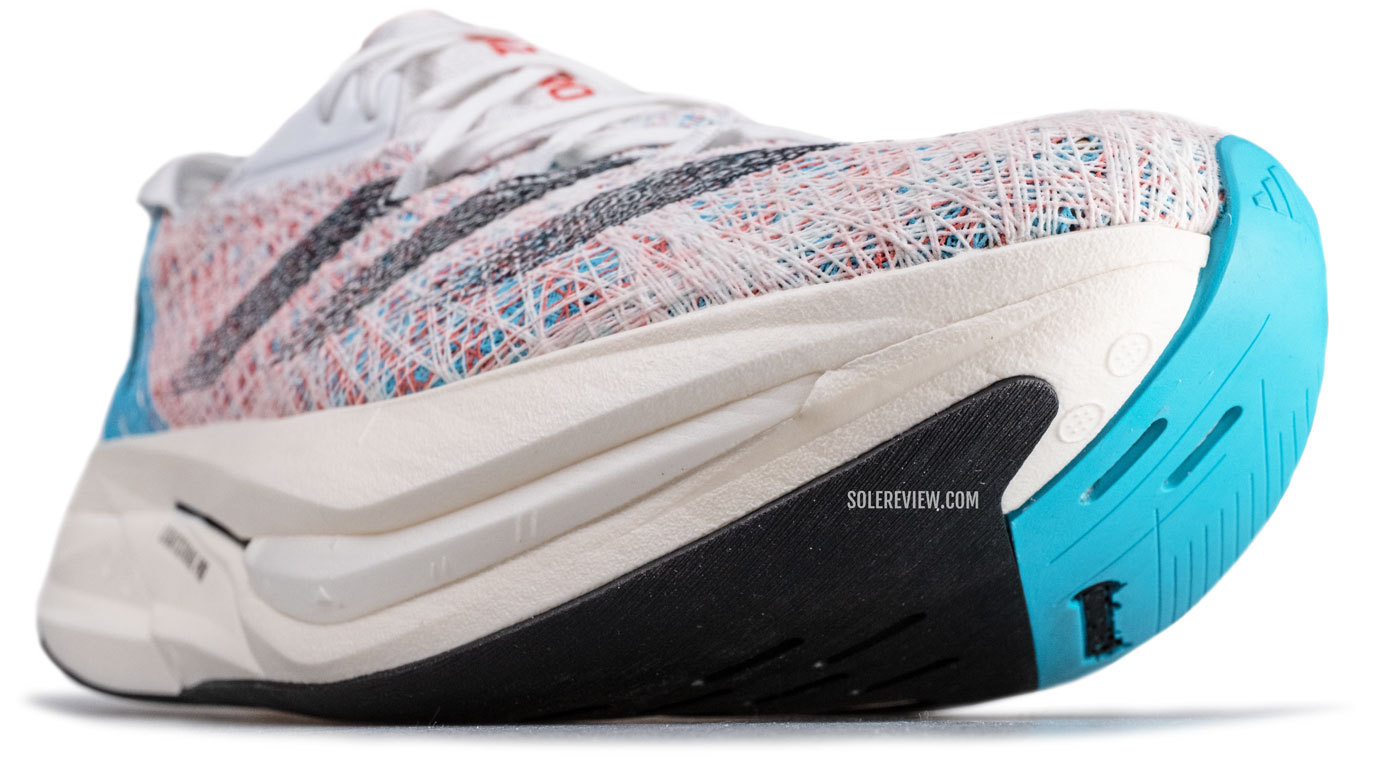
Of all the plated shoes with a rocker midsole, the Prime X2 is most eager to ‘tip’ the runner forward.
The midsole wastes absolutely no time rolling (or propelling) the foot forward, and this is also where the Prime X2 differs the most from the Prime X1 – as well as most other racers with a plate. While the stiffer rocker is a crucial component of the ride quality, it’s equally important to consider the height from where the foot rolls forward and down.
Let’s make this part clearer by comparing the rocker height of the Prime X2 with that of the Saucony Endorphin Speed 4, Saucony Endorphin Pro 4, Nike Vaporfly 3, and the Puma Deviate Nitro Elite 2.

Note: Measured from the medial (large toe) side. The total height includes the distance from the midsole bed to the ground, plus the insole (5-6 mm) thickness.
At 65 mm high, the Prime X2’s rocker casts a tall shadow over others. The adios Pro 3 has the same rocker height, but then, it doesn’t have the stiffness of the dual plates accentuating the rocker.
Of course, just the height alone isn’t enough to make the rocker propulsive. A midsole with a plate (or two) will deliver a far superior performance than an all-foam shoe with an identical rocker height. But in the Prime X’s case, all the conditions are in its favor – it’s got a high rocker height as well as the plate architecture and outsole placement.
Also, the rear ‘snap’ of the plate is made stiffer by the twin plates. The top plate is a cantilever beam of sorts, whereas the bottom plate acts as an anchor where the two meet under the midfoot.
This gives the top plate a much tighter snap as compared to the single plate configuration, as the support from the lower plate tries to resist the vertical loading force. This additional stiffness is perfect for the extra tall midsole.
So the Prime X2 has an aggressive rocker and a strong springboard snap. Does that mean it can go fast?
We’d be lying if we said the Prime X2 disappears on the foot during a run. At nearly 11 ounces, it’s a heavy shoe – and a bottom-heavy one at that. So while the Prime X never feels like a lightweight shoe at any speed, the weight isn’t a detriment to quickness, as long as it’s done a certain way.
And what way would that be?
During a run, the Prime X2 takes some time to find its rhythm. The tall and heavy midsole is a bit slow to speed up from a standstill, but the weight doesn’t seem to matter much once it picks up speed. Because once it kicks into high gear, the effective rocker does the rest.
A good analogy would be how a heavy rubber shotput ball behaves. It’s hard to get it rolling at first, but with sufficient momentum, the subsequent rolling happens without much effort.
At speeds, the midsole just loves to propel the runner forward; and designs with a high toe spring tend to behave so. On this site, our first encounter with a high rocker was with the 2012 Mizuno Prophecy, where we made a similar observation.
The shoe hums between 4:00 min/km (6:30 min/mile) and 5:00 min/km (8 min/mile) speeds, with the 4:30 min/km (7:00 min/mile) pace being its happy zone. It’s an excellent product for tempo efforts and generally maintaining a decent pace during a long run.
It’s not a shoe that likes to be flicked around corners. Straight-line cruising at the aforementioned speeds is what the Prime X2 excels at.
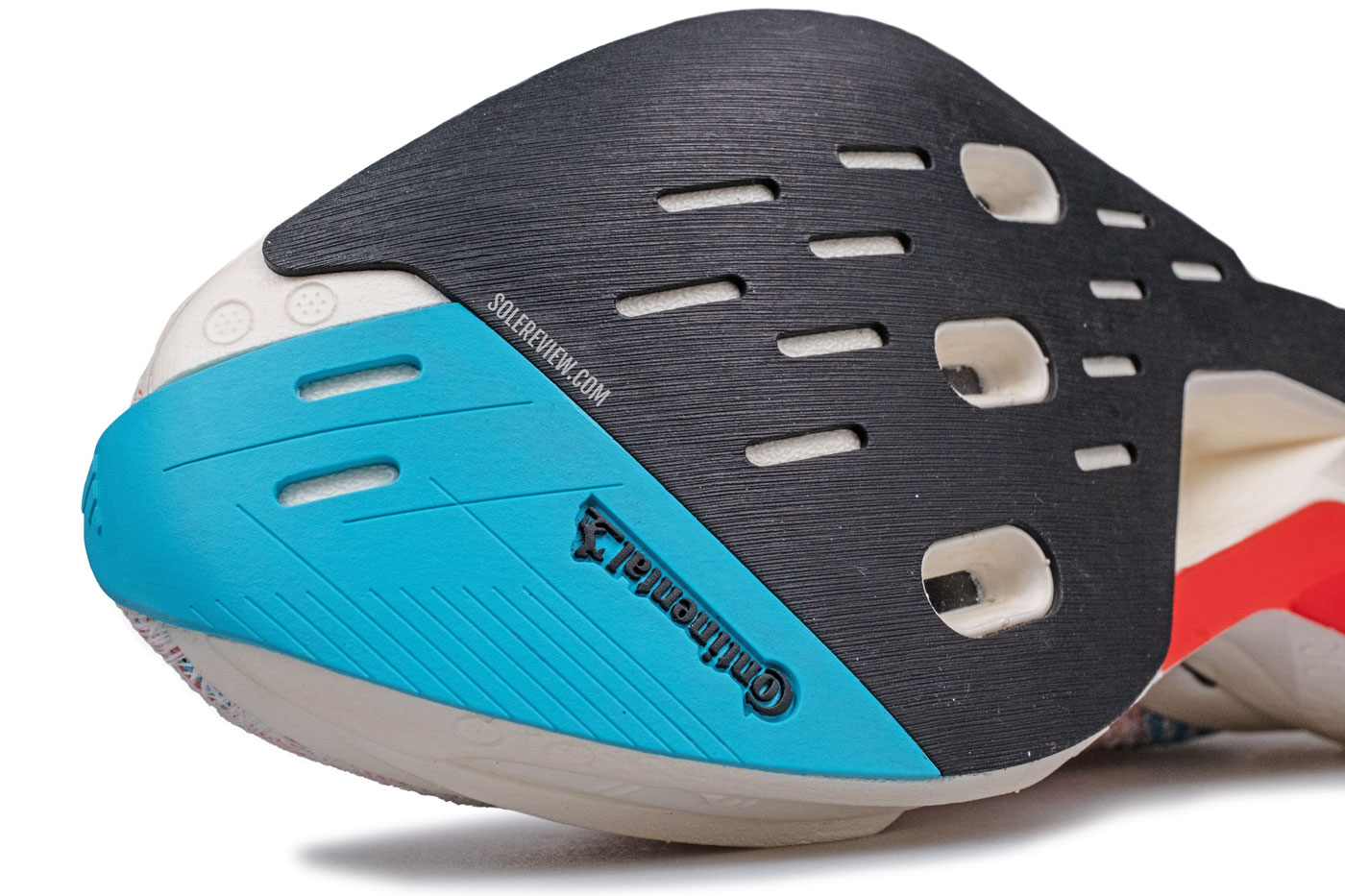
The outsole traction from the Continental compound is excellent. That said, the Prime X is weak at executing hard start-stops.
Bring all these together, and we have a shoe that’s good for marathons, pre-race training, and tempo runs. The Prime X2 Strung doesn’t fare well at interval training and mile repeats. It’s bulky, and the acute rocker midsole reduces the forefoot contact area from where to push off.
The healthy separation between the foot and the ground also mutes the ground feedback and proprioceptive abilities of the midsole, so speeds quicker than 4:00 min/km (6:30 min/mile) are better reserved for lower-profile shoes with superior road feedback.
How what happens if a runner doesn’t want to go fast, or also wants to run in the Prime X2 on a slow or ‘recovery’ day?
It’s perfectly alright to go slow on the X2; easy speeds will still give you same absurd amount of cushioning as well as the stabilizing effect from the stiff plates that would otherwise not be available on all-foam shoes.
At the same time, slow speeds make reaping all the benefits of the midsole all that harder. A runner going 7:00 min/km (11 min/mile) will have a completely different opinion of the Prime X2 than someone who is clocking 4:30 min/km (7:00 min/mile) on the same shoe. It’s going to be an underwhelming experience.
So it’s important to know what the Prime X2 is capable of, even if you don’t run within the shoe’s Goldilocks zone. It’s worth keeping in mind that this costs $300 (our reviewed pair cost us more with the sale tax), so what’s the point if the shoe isn’t pushed to its performance boundaries?
Besides the diminished rocker effect, a few other things take place at slower speeds. Slower paces do a weaker job of activating the plates – both the Cantilever effect under the heel and the easy-to-roll-forward rocker under the forefoot.
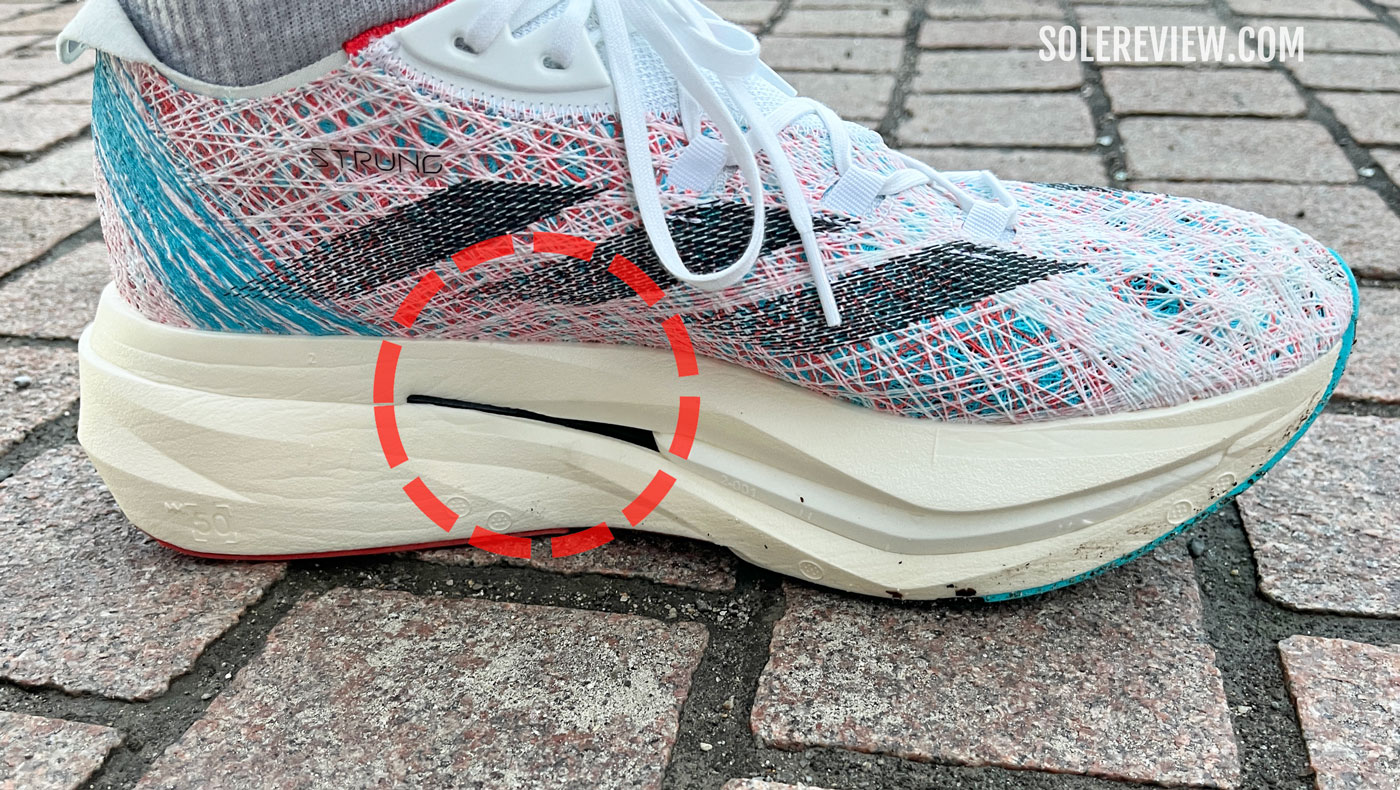
The firmness of the plate joints becomes noticeable at slower speeds. This dissipates as the shoe picks up speed.
Slow runs also cause the midsole edge to press up against the arch. This is where the two plates are stacked together where the midfoot ends and the rearfoot begins. At faster speeds, this isn’t noticed because the arch doesn’t dwell long enough on the midsole edge.
The slower the running speed, the heavier the Prime X2 feels. The opposite is also true, and that’s why the shoe feels best when cruising within its optimal performance boundaries.
THE PRIME X2 STRUNG COMPARED WITH PRIME X1 STRUNG
Whether one prefers the Prime X1 or the Prime X2 is going to be subjective. What we’re going to do here is to provide an objective overview of both the models, and let the reader decide.
A quick recap is in order. The Prime X1 was a lighter shoe with a different internal setup. Instead of two plates stacked inside, it used two different layers of articulated ‘rods’ – it’s almost as if the rods from the adios Pro 3 were laid over the flatter ‘forks’ of the adizero adios 8.
There was no cantilever-type plate under the heel, but rather a short ‘base plate’ of sorts. As one can imagine, the Prime X1 had a very different ride than than X2. The changes can be summed up as follows:
1. On the Prime X1, the more flexible ‘Energy rods’ and floating heel plate let the cushioning properties of the Lightstrike Pro foam come to the foreground. The midsole was bouncier, more lively and softer overall, as the (more) flexible parts had lower stiffness. On the flip side, the midsole had lower stability than the PX2 with a higher tendency to throw the wearer around.
2. Even with similar rocker heights, the Prime X1 was less propulsive than the Prime X2, and therefore not as quick. The two plates on the PX2 make the rocker effect more pronounced by adding stiffness, and this increases the ‘roll down and forward’ quality. Also missing on the PX1 was the Cantilever beam effect under the heel.
3. The Prime X1 had a narrow performance gap between slow and fast speeds. The Energy rods and heel base plate did not require as much loading force to ‘activate’ as the plates, as they were fairly flexible to begin with. It’s worth mentioning that the PX1 was 1.8 ounces lighter, so it didn’t feel as bottom-heavy during recovery runs. Overall, the PX1 was more ‘user friendly’ than the prescriptive PX2.
4. The PX2 will not ‘break in’ the way the PX1 did. The PX1 had Energy rods, and like most adizero shoes that have it, the rods required some time to bed in. The PX2? Not so much. The dual-plate design is considerably stiffer than the Energy rods, so the shoe is not going to become more compliant over time. Contrary to popular belief, the Lightstrike Pro foam does not need a break-in period; the stiff components do.
5. The PX2’s upper is much harder to get into. The entry is now a bootie-type rather than the more conventional design of the PX1. The tongue lacks any padding, so the top-down lacing pressure is more noticeable.
The thick band/loop on the PX1’s tongue did a better job of filtering the lacing pressure than the PX2. The PX1 tongue had a shallow foam pocket on the underside as well as a thicker synthetic suede material.
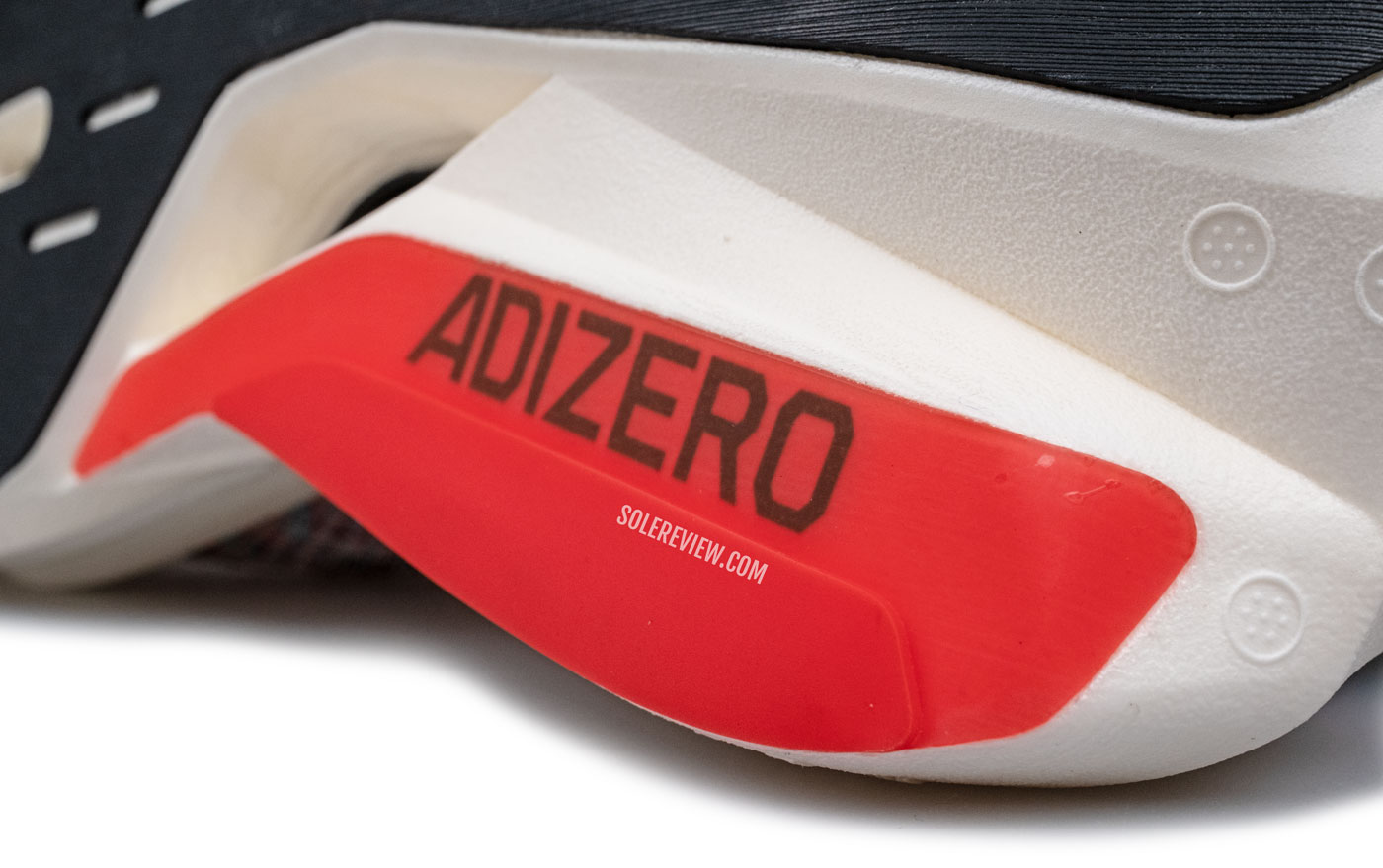
The Prime X2 gets a new outsole with better coverage and a different surface texture. The grip is just as good as the PX1.
There are other minor updates like the Continental rubber outsole’s texture changing from ribbed to flat. The outsole also fills over the midsole gap of the PX1 (it was the window for the Energy rods).
What of the upper? Is it an improvement over the Prime X1, or does the redesign take a step backward? Our opinion is that it’s the latter, but first, let’s address the basics.
THE UPPER DESIGN AND FIT
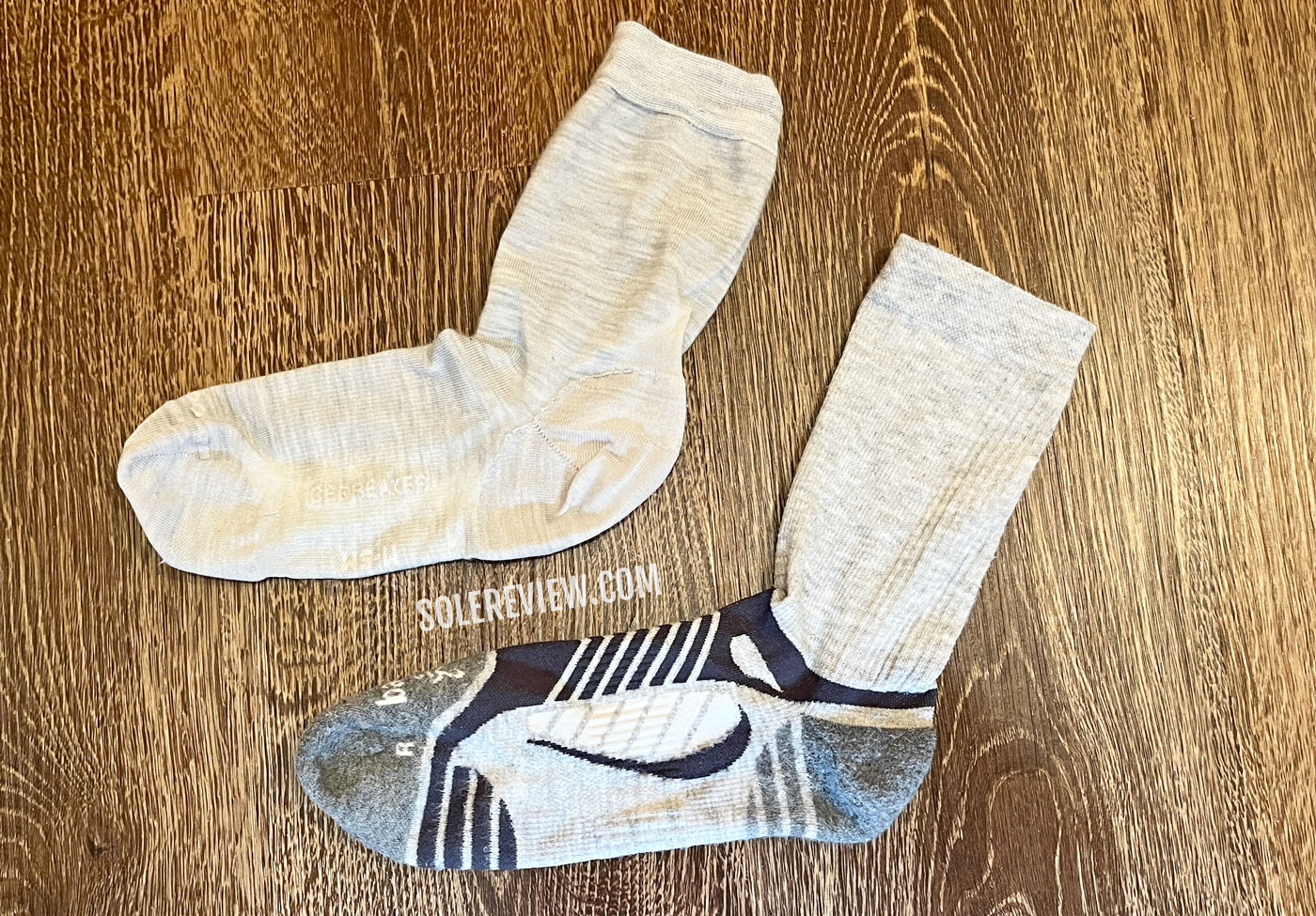
With the Prime X2, choose your socks wisely. Get a pair of cushioned socks (bottom) for best results.
The Prime X2 Strung fits true-to-size, but with a caveat. One needs to pair it with cushioned running socks – not just to achieve a just-right forefoot and toe box fit, but also to create a better connection with the midsole. A snugger fit does a superior job of transferring the power from the foot to the midsole.
A thin running sock will achieve the exact opposite. The foot swims inside the unstructured toe-box, while opening a half-size worth of extra room. Running barefoot in the Prime X2 is not recommended.
So why does the Prime X2’s fit have such a wide variance depending on the sock type? To a certain extent, this observation will apply to most running shoes. However, why the Strung X behaves thus is a function of its upper design and materials.
Most shoes have some degree of default snugness – either through the toe bumper, elasticity of the mesh, or the shape of the last.
Those attributes do not apply to the Prime X2, so the change in interior volume (via thick socks) has a much greater impact on the overall fit. Also, the fit contrast between the tight sock-like entry and roomy forefoot is quite noticeable.
In the forefoot and toe-box area, the ‘Strung’ mesh has absolutely no give, compression, or stretch of any kind. The toe box doesn’t even have an internal bumper.
The lacing reaches further into the forefoot than most non-adidas shoes, so the upper responds positively when laced tight. A cushioned sock will result in less bunching and will make the lacing more responsive.
The ventilation is decent, and most runners will have no breathability-related complaints.
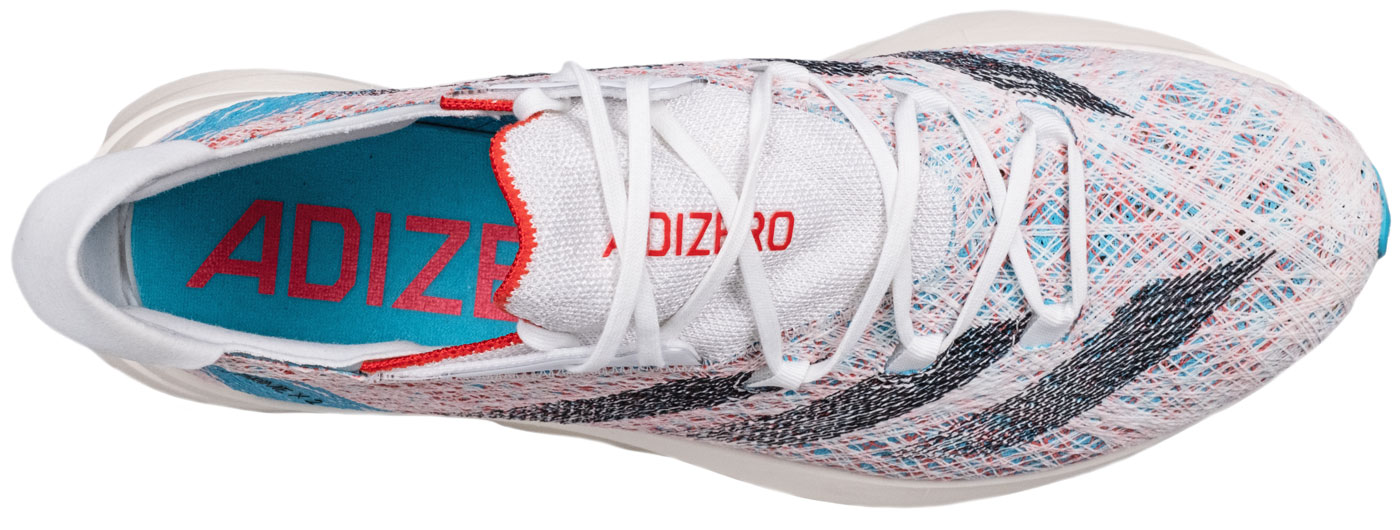
The new upper is harder to get into because of the new sock-like tongue. The lack of padding also lets the lacing pressure through.
A thicker sock also works better under the tongue. The X2 adopts a tighter sock-like entry with an integrated stretch tongue. The tongue doesn’t have any padding, so the top-down lacing pressure is noticeable with thin socks. A cushioned sock does a slightly better job in that aspect.
There’s a downside to wearing a cushioned sock, and that’s the ease of entry. The sock-type upper is much harder to get into than the PX1, so thick socks make the entry tighter.
While adidas provides a foldable lip that doubles as a pull tab, it’s too short to be of any use.
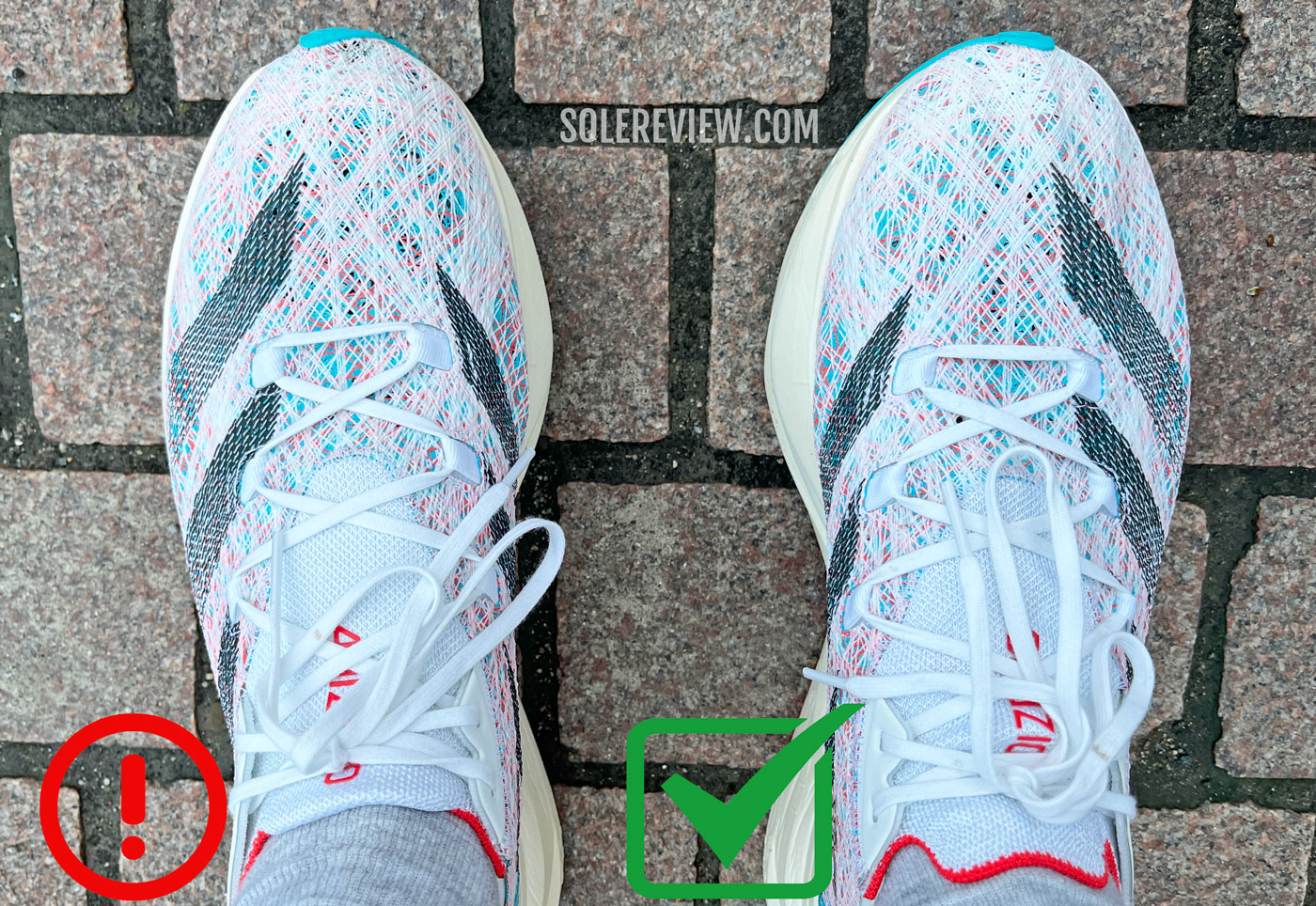
Note how the tongue of the left shoe is folded in. This is a common occurrence with the Prime X2 Strung due to the tight sock-like entry.
The tongue edges also tend to fold in during each wearing, and one has to reach under the tongue flap to smoothen it. If the flap isn’t stretched flat over the foot, the folds are sensed during a run.
There’s also the matter of the infamous stiff eyelets on the Prime X2. Most runners with a regular instep profile and cushioning socks will be able to tolerate the stiff eyelet, but the shoe can certainly do without it.
Exceptions will apply for runners with a broad instep, where the eyelets have a greater chance of irritating.
As long as the Prime X2 is worn with cushioned socks, the heel will deliver satisfactory levels of grip.
While the PX2 loses the runner’s loop eyelets from the PX1, they’re not sorely missed. That being said, the Prime X2 would have greatly benefited from an internal heel counter, even if it were not full-sized. We say this for two reasons.
The midsole doesn’t have raised sidewalls. The foot sits on top of the midsole rather than seated in, so there’s no cupping action to stabilize the heel. During runs, there’s this sense of insufficient support at the base of the heel – a rigid counter would have remedied it. And besides, another gram or two isn’t going to matter on an 11-ounce shoe.
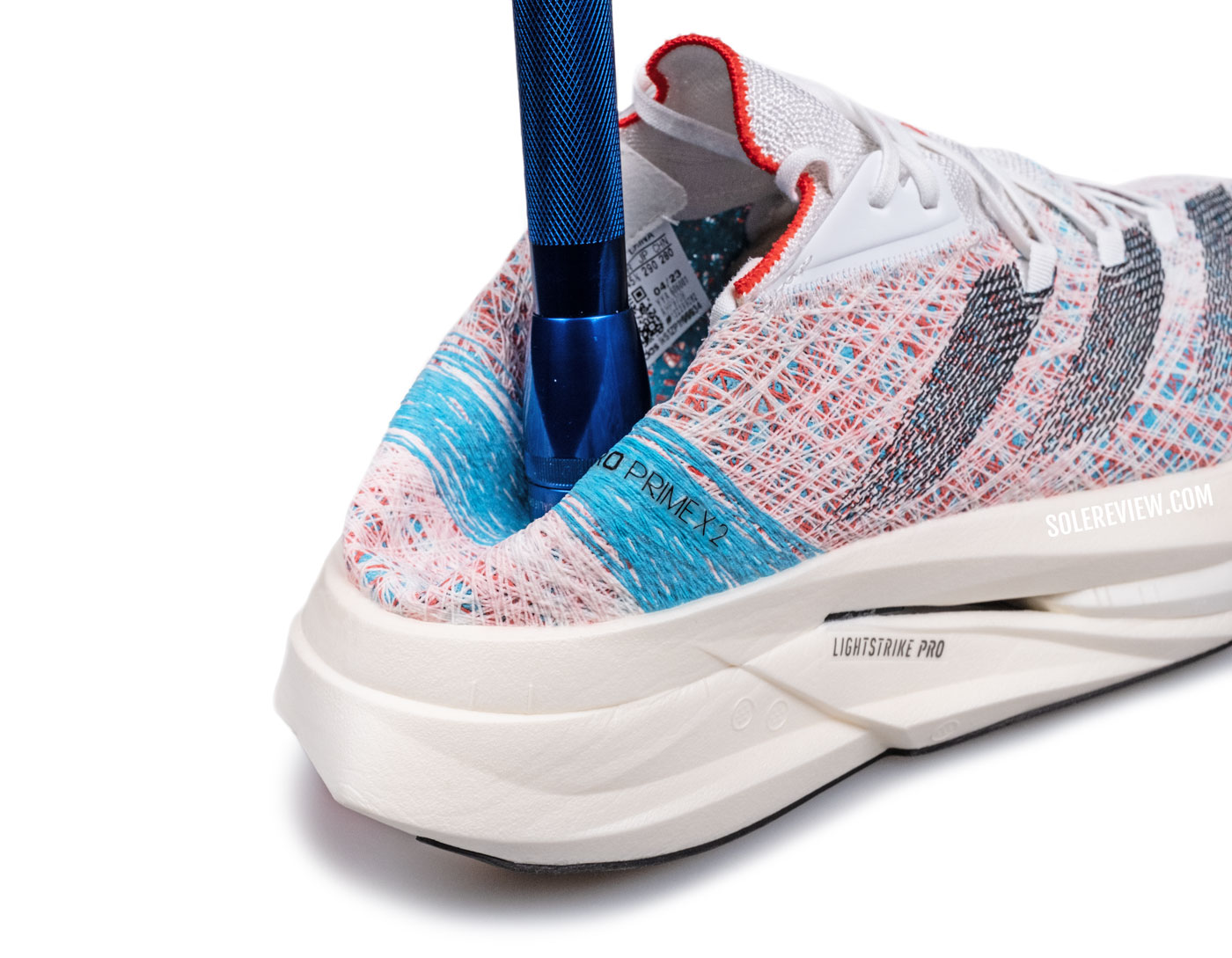
The Prime X2 would have been served well with a stiff heel counter. That would have improved the midsole stability as well as the quality of the heel grip.
A collapsible heel is a good fit on lighter and lower stack shoes like the adios Pro 3 and Takumi 10. But a heavy shoe like the Strung X2 should have heel support, no two ways about it. The sparse padding isn’t enough to inspire confidence.
The footbed is a flat type without a curved arch, so there’s no chance of irritation.
If you’ve made it so far, we hope you realize that the Prime X2 Strung is not going to be liked by everyone.
Most runners will do just as well without spending Prime X2 money. The adidas adios Pro 3 has an identical rocker height and Energy rods – those are easier to work with at all paces than the dual-plated stiffness of the PX2. So that’s a solid option right there, and you still get to run on the resilient Lightstrike Pro midsole.
Runners who are looking for lighter yet stable plated racers would be served well by the Endorphin Speed 4 as well as the Puma Deviate Nitro Elite 2. For a plated shoe, the Deviate Nitro Elite 2 is very rearfoot strike-friendly and is priced lower than most high-performance racers.
Do you own this shoe? Improve this review by sharing your insights.

